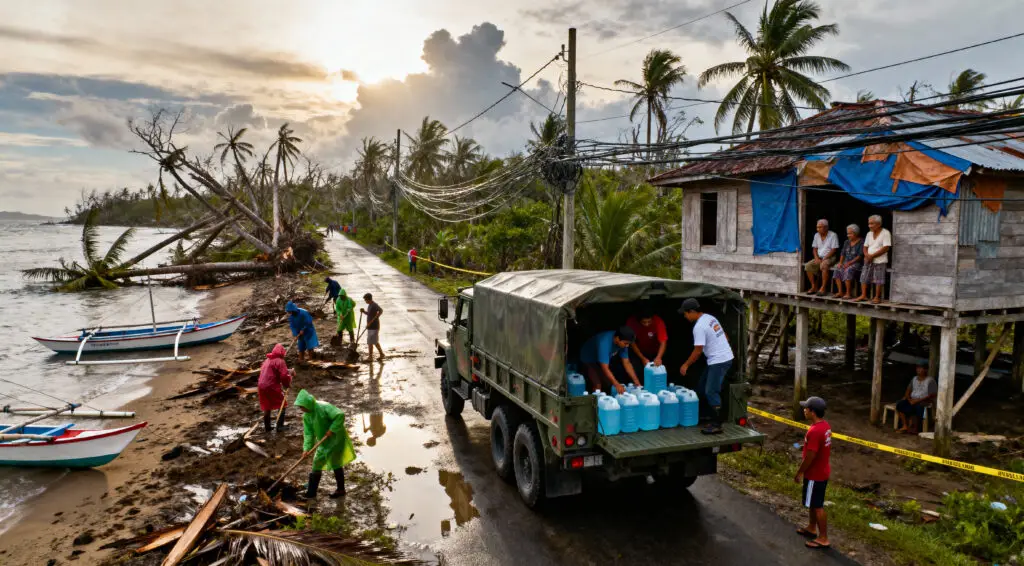Dinagat Reels as Typhoon Tino Revives Painful Memories of Odette 2021
The island province of Dinagat is once again in crisis as Typhoon Tino (Kalmaegi) tore through the region Monday night, leaving destruction reminiscent of Typhoon Odette’s devastation in December 2021. As dawn broke, locals awoke to damaged homes, blocked roads, and power outages, confronting a haunting sense of déjà vu.
Initial reports from local officials indicate widespread infrastructure damage across Dinagat’s seven municipalities, with communication lines down and emergency access severely limited. Authorities have begun early road-clearing operations and rapid assessments to determine the full extent of the damage.
Memories of Odette’s Destruction Resurface Across Dinagat
The trauma of Typhoon Odette remains etched in the collective memory of Dinagat’s residents. In 2021, Odette ravaged the islands with winds up to 240 km/h, flattening homes, uprooting trees, and cutting off the province from the outside world for days. Then-Governor Arlene Bag-ao described the province as “leveled to the ground,” with 95% of homes either damaged or destroyed.
Four years later, Typhoon Tino’s arrival stirred painful memories. “The ordeal was dili lalim (very serious),” said Congresswoman Arlene Bag-ao, who recounted the night of the storm in a social media post. “Families once again fled to higher ground as howling winds and darkness took over the island.”
Residents Endure Power Failures and Communication Blackouts
By early Tuesday morning, large portions of the province remained without power. While electricity had been restored to some areas intermittently, unstable voltage and fallen transmission lines continued to hamper recovery efforts.
Communication was equally disrupted. Mobile networks were unstable, leaving families unable to reach relatives or emergency responders. Local officials reported that coordination with national agencies was being conducted through satellite channels and intermittent radio contact.
Governor Nilo Demerey Jr. confirmed that road-clearing crews began work before dawn, with priority given to major routes leading to hospitals and coastal evacuation centers. “Our teams are working nonstop to reconnect communities and ensure that help reaches every barangay,” he said in a statement posted at 3:45 a.m.
Recommended Article: Deadly 6.3-Magnitude Earthquake Strikes Northern Afghanistan, Killing Nine
Relief Operations Underway Amid Harsh Weather
Despite ongoing rains and high winds, emergency relief efforts began at daybreak. Evacuation centers across the island opened their doors to displaced families, while military and coast guard units prepared to deliver food and medical supplies as soon as ports reopen.
Local government units coordinated closely with the Office of Civil Defense and the Department of Social Welfare and Development (DSWD) to pre-position essential goods in nearby hubs such as Surigao City and Southern Leyte. However, rough seas continue to impede transport of larger shipments of relief materials.
Lingering Fear and Emotional Toll on Dinagat Communities
For residents who lived through Odette’s aftermath, Typhoon Tino’s impact has been emotionally overwhelming. Survivors recall walking hours through debris-strewn terrain just to find a signal to call for help in 2021. Many fear history is repeating itself.
“I thought we would never see something like Odette again,” said Maria Lopez, a mother of three from Basilisa. “But last night felt exactly the same — the wind, the noise, the fear. We just held on and prayed.”
Mental health professionals have warned that repeated exposure to natural disasters compounds trauma, especially in isolated communities. The Department of Health is preparing to deploy psychosocial support teams once roads are fully accessible.
National Agencies and NGOs Mobilize for Emergency Response
As reports of damage reached Manila, national agencies and non-governmental organizations (NGOs) began mobilizing relief convoys to assist Dinagat. The Armed Forces of the Philippines has placed nearby units on standby for rescue operations, while the Philippine Red Cross has sent rapid response teams to assess needs and provide emergency medical aid.
The National Disaster Risk Reduction and Management Council (NDRRMC) confirmed that Typhoon Tino has made multiple landfalls — first in Southern Leyte, followed by Cebu, Negros Occidental, and Guimaras — bringing torrential rains and powerful gusts to the central Philippines.
Lessons from 2021 Guide Dinagat’s New Response
Unlike in 2021, local authorities in Dinagat had several days to prepare before Tino’s arrival. Preemptive evacuations were conducted in flood-prone and coastal barangays, and critical supplies were stockpiled. Officials credit the early warning system improvements since Odette with saving lives.
Governor Demerey emphasized that the island’s experience with Odette shaped its current disaster readiness. “We learned the hardest way possible four years ago,” he said. “Now, our goal is zero casualties — every life matters.”
A Call for Continued Support and Long-Term Recovery
As the storm moves toward the Visayas and out of the Philippine Area of Responsibility, Dinagat faces another uphill battle toward recovery. Local officials have appealed to the national government and private partners for aid, fuel, and rebuilding funds to restore power, rebuild schools, and repair damaged fishing ports.
For Dinagatnons, resilience has become a way of life. Yet many now hope that the lessons of Odette — and the painful repetition brought by Tino — will finally lead to sustainable rebuilding programs that can withstand future storms.
“The wind may destroy our homes,” said a resident from Libjo, “but it cannot destroy our will to rise again.”























